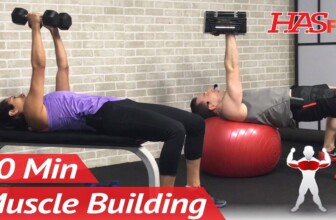Brick House CORE with only 2 exercises: Functional abs with kettlebells
Mover's Odyssey Kettlebell Mastery Program: https://moversodyssey.gumroad.com/l/kettlebell_codex
Kettlebell Poster Link: https://moversodyssey.etsy.com
Adjustable Kettlebells: https://bellsofsteel.us/collections/kettlebells#a_aid=moversodyssey&a_cid=11111111
Website: https://www.moversodyssey.com
https://www.instagram.com/movers_odyssey/
A truly strong core requires more than just abdominal work, it requires the integration of numerous muscles and connective tissues all working together. A useful core is one that protects the spine, has the mobility to move in all directions, and can create and transfer strength across the body. Too many core routines focus on only the visible abdominal muscles and not on the actual functional strength of the midsection. Kettlebells offer a great way to target the core in more of a functional manner.
#kettlebell #kettlebelltraining #corestrength
[Music] A weak core is a quick path towards back pain
poor athletic performance and a general lack of strength in real world situations. A common
cause of weak core musculature in otherwise fit individuals is the overreliance on single
plane motions largely focusing on only the highly visible rectus abdominis muscles. This translates
poorly to truly functional strength because in real world situations the core muscles must
operate through multiple planes of motion while coordinating a multitude of muscles to accomplish
many simultaneous tasks. Because of this you could have the strongest ABS in the world and still
have a weak and dysfunctional core. For the core to be truly strong and functional in real world
scenarios it must meet certain requirements. First and foremost it must protect the spinal
column from injury and the deteriorating effects of chronically poor spinal posture. This
requires stabilization strength, without which the chances of injuries such as disc herniations, muscle
strains and vertebrae stress fractures greatly increases. Secondly the core must have good
mobility in order to produce a wide range of potential movements in the trunk and spine. This
means the muscles of the trunk must be supple enough to allow the breath to fill the lungs
without resistance and allow the spine to bend and move in all directions while still being
stable enough to protect the spine in the process. And finally the core must be able to not
only produce its own movement and stability but it must also be able to integrate with the strength
of the entire body. A functionally strong core has well-developed musculature and connective tissue
Pathways that are used as strength bridges, which connect and transmit forces generated by
the lower body into the upper body and vice versa. In the world of core training there are
hundreds of excellent potential exercises and what's best for each individual will be based
on their own peculiar condition, posture, and fitness goals. In this way exercise selection and
programming can truly become a biomechanical art form unique to each individual. However, in
this video I'm limiting myself to just two kettlebell core exercises that adhere to the
principles mentioned before and which I've personally seen have significant benefits for
nearly everyone who has performed them properly. Loaded carries of all kinds are amazing exercises
for real world strength adaptations. After all the most common strength-based task needed in real
world scenarios is the ability to carry something. In the context of core training carries create
excellent adaptations towards spinal stability often called anti-rotational or anti- movement
strength. The simplest of these carries is the common farmers walk where a weighted load
is placed in either hand and held at the side while walking. The variation chosen for
this video however, is the single arm Farmers carry. Often called the suitcase carry. In this
case the weight is imbalance from one side to the other. This will cause you to want to lean to
the other side and distort the spine in order to use your body weight as a counterbalance. However,
that would be letting the weight win and dictate the nature of the carry. Instead, the goal of this
exercise is to use muscular effort to resist the distortion of the spine and to hold yourself
in a neutral and balanced posture. To do this you need to make sure you're stacking
the pelvis and the ribs in a horizontal orientation. No rib flare, no pelvic tilt, and
no rounding of the back. While also maintaining horizontal hips and shoulders when viewed from
the front. Walking towards a mirror can be very helpful in the beginning as it allows you
to accurately gauge the neutrality of your posture. Done properly this greatly strengthens
and stabilizes the core muscles especially on the opposite side of the kettle bell, as they
work to resist the lateral pull of the offset load. The next kettle bell exercise we're going
to go over is the kettle bell windmill. This exercise bumps up the complexity quite a bit.
Not only will the cord need to stabilize the spine and simultaneously produce movement it
will also have to coordinate its movement with that of the hips and the stabilization of the
shoulders. The windmill not only increases the strength and functionality of the core, it is also
a great mobility builder for the hips, hamstrings, calves, shoulders, and thoracic spine. In fact, it's
a remarkable rehabilitative exercise for thoracic extension and rotation, which is a common mobility
weakness in those with upper cross syndrome. Often leading to upper back pain and shoulder pain
when lifting overhead. his is another exercise I recommend people start slowly with especially
in the beginning. For the hips and low back this is a form of loaded mobility training, which is
by far one of the best ways to truly rehabilitate mobility ranges. But unfortunately, also
leaves the body vulnerable to strains in the very beginning, especially if you try to
push through it before the body is truly ready. This is particularly true of the QL muscle in the
lower back. For many people this muscle is weak, tight and barely used and it will take time for
it to come back online and to become mobile once again. Because of this, I recommend people to start
with this as a body weight mobility drill for at least a week or two before adding a lightweight
kettle bell. To perform this exercise, stand with the feet a little wider than shoulder width apart.
With a kettle bell held overhead in one arm. Turn the feet away from the kettle bell by anywhere
from 15 to 45° depending on what's comfortable to your unique body. You will keep the leg that is
directly underneath the kettle bell straight, while allowing a slight bend in the other knee. Your arm
will stay straight throughout the entire movement. You will start the movement by hinging at the hips
and pushing back into the hip that's underneath the kettle bell as you bend down. While hinging
you will also begin to rotate the spine so that the bottom hand reaches between the legs. Keep
the spine straight throughout the movement and follow that that same path back up until you're
standing tall with arms still fully outstretched over the head. Remember this is a whole body
exercise where the core is training to work together with other muscles to create stability,
mobility, and strength. You should be driving the weight up with not just the core but also with
the hip extensors, especially the glutes and hamstrings. If this is difficult due to mobility
issues in the hips, you can add a little extra bend in the knees until you gain more mobility.
If you have trouble with shoulder mobility, try the low windmill version first, with the kettle
bell in the bottom hand, before eventually moving on to the standard high windmill. And if this
all becomes easy for you to perform with skill throughout at least 12 reps, you can always
progress into the double windmill, holding a kettle bell in each hand. If you use kettle bells
at home or interested in starting a kettle bell routine, check out my new Illustrated home gym
poster by clicking the link in the description box below. It has multiple exercises tips, a
kettle bell grip guide, and a kettlebell weight chart for those new to this training modality. Well
that's it for the video. Thanks for watching and be sure to leave a comment if you have ever utilized
these exercises in the past or if you're doing so now and have any tips or tricks that you would
like to share with others. Also if you enjoyed the content be sure to like and subscribe
and until next time, keep moving my friends.
#Brick #House #CORE #exercises #Functional #abs #kettlebells
source











Hey, I would love to ask is it possible to do these exercises with dumbbells instead of kettlebells?
At the moment I'm tight financially and I tried doing swings with a dumbbell instead of a kettlebell but stopped because of injury fear.
Does the shape of a kettlebell play that big of a role it is it acceptable to do the same exercises with a dumbbell?
Thank you very much for your time in advance
Many weak core hugs 😂 from Greece
I wish I could find a trainer in my area that could work with me taking into a out all my injuries, and help me regain a strong flexible core
Being patient green light new location and resident… fingers crossed
Yes: thanks for the content and the illustrations are awesome.
I keep finding AI slop videos just stealing the concept and information from this video
kb windmill is new to me, thanks!
Cant wait to leave. Everything behind me .
first – the best diet today is:: "The Optimum Human Diet" –the ebook. now, on topic: testosterone – 4 to 8/10 reps builds size, HGH – 12 reps increases strength mostly and more lean mass or lean type of growth compared to test. mostly size and muscular development/s. you got cell surface hormones – peptides(small/short proteins) – HGH, IGF-1 = speed and strength, and then you got internal cell hormones – cholesterol or steroid hormones = size and differentiation/development/s. Thank Y'all. 👂🪿🌮🧬🦍🌯🐽🐷🐷🐖🐖🏋♀😉💪(anabolic hormones like HGH first bind to receptors in the cell or on the surface of the muscle cell where it stimulates biochemical reactions that lead to transcription factors entering the nucleus and the transcription of genes for muscle growth and development where the end product is a protein from the hormonal cascade. so the hormone/receptor complex stimulates inner cell cascades that go to the nucleus and stimulate the production of proteins, is how hormones work.)
to get rippled and lean with little size you do the 3/4 carbs 1/4 meat. That's about it.
How many reps and sets should I do per week? I want to develop functional strength
I just started taking a 30 lb dumbell on walks with my friend. I like pairing it with normal walks, it makes it a lot more enjoyable
Can dumbbells be used for this exercise and get the same results?
The only reason I don't like the farmer walk is because there's very little space to walk around in my gym and it's quite full of people as well.
Wish there was a demonstration video.
My ribs naturally stick out on the left due to a deformity called "pectus carinatum" would this effect my ability to do these safely?
One of the few excellent videos I found about this topic. Thank you very much.
Jesus loves you all ❤️ Philippians 1:6 And I am certain that God, who began the good work within you, will continue his work until it is finally finished on the day when Christ Jesus returns.
Do not stop to improve people’s sport
A "Neutral pelvis" IS NOT flattening the low back, this is what causes herniation, the lumbar vertebrae are naturally wedge shaped and MEANT to loaded as an Arch. This "Neutral pelvis"
idea is BULLSHIT
Do you have a Displate option for the poster, it would be more metal, than getting a paper one
You deserve more subscribers great content ❤
How many days a week do you recommend this training?
Thank you so much!
it was the most helpful video of 2025!
Can't believe it's free to watch!
is there any way to do these without kettlebells?
The "trunk and spinal mobility" drawing had me roaring, please make that into a t-shirt print😂
would of been so much better and should of been done with a real person instead of all these drawings!! didn't get a thing from this!!
How would you program these? Before a core workout?
I've just tried windmills for the very first time, bodyweight only, one set per side of ten reps each.
That's a bloody awkward movement!!
These videos are great as is. Educational and instructive. Thank you.
art direction in these videos are sick
This channel deserves millions of suscribers
Deserve more attention but i lowkey want to keep it to myself
Very good 👍🏻
Love your content… Definitely going to utilize this info…
Thank you for this video.
YEA, These exercises will make you strong with many more benefits.TRY THESE OUT.
Could I do these with a dumbbell instead?
Oh man, just discovered this series and it's great! I love the look. I'm also an animator who does this kinda stuff and I love the colors and use of graphics. Well done to all involved! If you ever need some help with the artwork let me know.
Bro can you make video on oblique exercises with kettlebell
how long or many repetitions should the suitcase carry be
Can you make a video on how to lean the handstand please